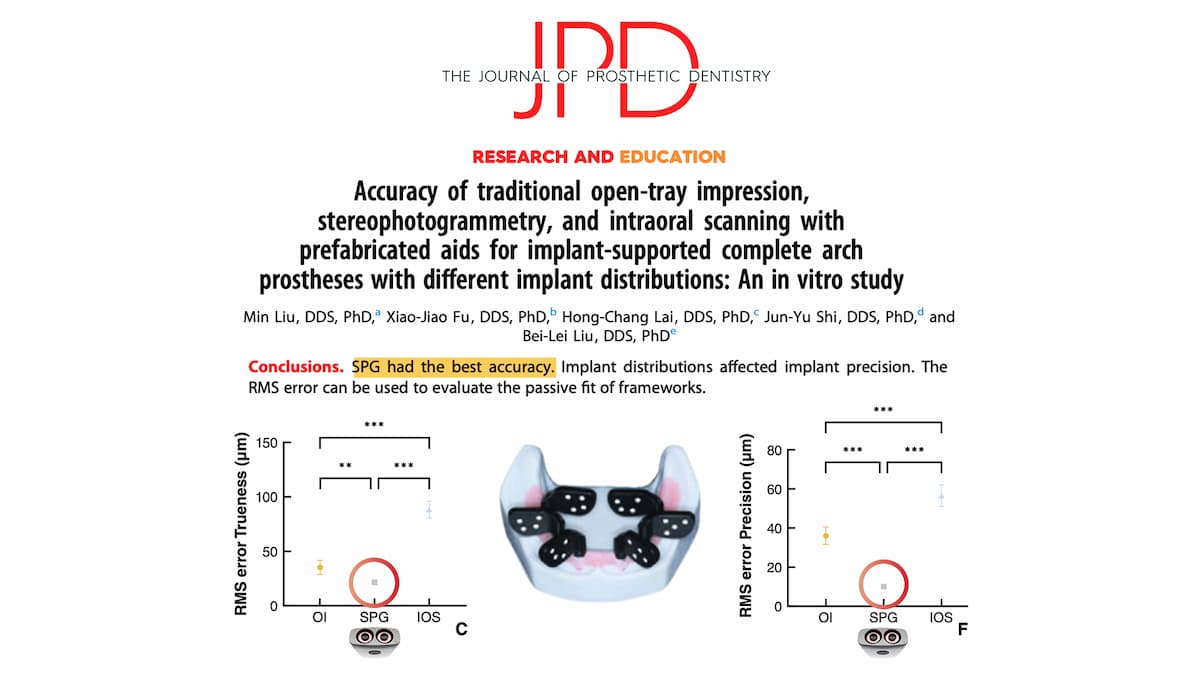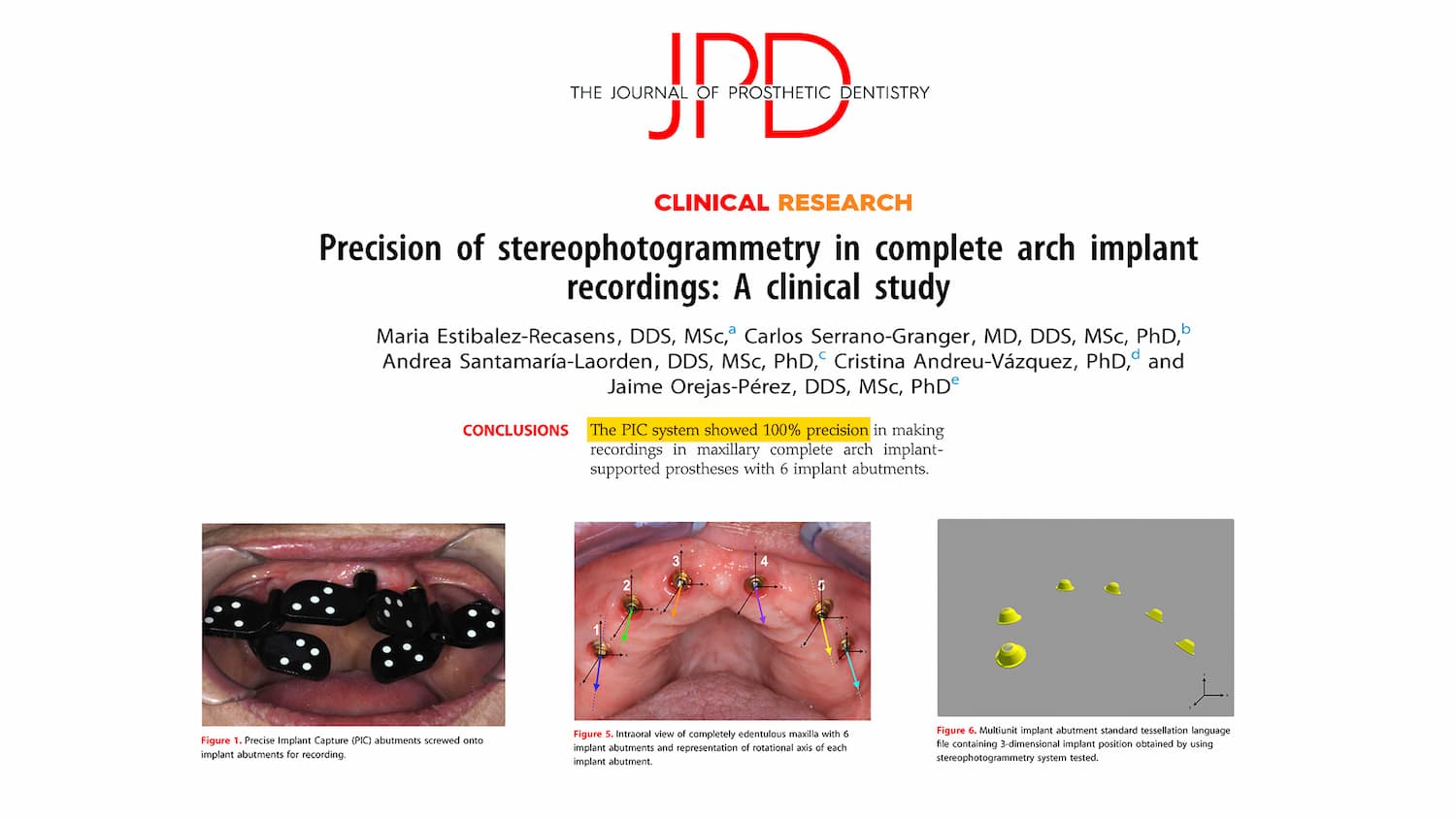A new research paper featuring the PIC system was published this July in the Journal of Prosthetic Dentistry. Carried out by Dr. Min Liu and her collaborators, this in vitro study compared the accuracy of the PIC system Legacy with an intraoral scanner and an open tray impression. The PIC system Legacy delivered the best trueness and precision in all scenarios.
This study is the 32nd (!) peer-reviewed scientific publication so far validating the performance of PIC dental's solutions. This growing body of in vivo and in vitro research overwhelmingly proves the industry-leading role of the PIC system in providing a predictable, guaranteed passive fit in full arch restorations.
The team of researchers made 10 repeat captures with each method on three different full arch models with varying implant numbers and angulations. The models all had abutment-level analogs. PIC system users can choose between working with direct to implant or abutment-level PIC transfers depending on their preferences and the needs of a clinical case.
Dental research evaluating accuracy usually follows the ISO 5725-1 standard, where accuracy consists of both trueness (how close a measurement is to the true result) and precision (the conformity of multiple repeated measurements). This approach enables a mathematical assessment of the accuracy of different methods by determining mean values of deviations.
Liu et al. also used a novel passive fit scoring method. The best and worst recordings of each method were used to mill aluminum frameworks which were then attached to the models. An explorer probe with a 60 micron tip was used to detect and measure the number of gaps between the framework and the analogs.
%20-%20Julio/2024-07%20-%20Scientific%20study%20Min%20Liu%20et%20al/2024-07%20-%202024-07%20-%20Scientific%20study%20Min%20Liu%2c%20et%20al%2010.png)
This additional evaluation gets the in vitro comparison closer to a real-world scenario. The manufacturing tolerances of a prosthesis increase the deviation of the fit. In a clinical setting, this makes the accuracy of the method used to measure implant positions critical to the treatment's predictability. An acceptable deviation during implant measurement may not provide a passive fit when compounded with the deviation introduced by manufacturing, whether it's 3D printing, milling or laser sintering.
Results
The PIC system Legacy was the most accurate implant measurement method in the study. It performed dramatically better than intraoral scanning and open tray impression across both trueness and precision of distances and angulations, as well as in the passive fit scoring test on milled frameworks.
With a mean RMS trueness of 21±4 microns and mean RMS precision of 9±7 microns, the findings follow the positive trends established by previous in vitro and vivo research of the PIC system.
%20-%20Julio/2024-07%20-%20Scientific%20study%20Min%20Liu%20et%20al/2024-07%20-%20Scientific%20study%20Min%20Liu%2c%20et%20al%20-%20results%20RMS.jpg?width=648&height=352&name=2024-07%20-%20Scientific%20study%20Min%20Liu%2c%20et%20al%20-%20results%20RMS.jpg)
For over a decade, scientific research has provided independent, empirical validation of the PIC system's accuracy. The findings have significant implications for dental professionals worldwide looking for best-in-class, evidence-based solutions to enhance their patients' outcomes with predictable full arch restorations.
This study uses the original Legacy generation of the PIC system, first released in 2009 and discontinued since 2022. While it’s no longer available for sale, it continues to be the most validated dental photogrammetry solution for a guaranteed passive fit and is still used daily by dental practices all around the world with excellent results.
%20-%20Julio/2024-07%20-%20Scientific%20study%20Min%20Liu%20et%20al/Legacy%20to%20new%20PIC%20system%20formats.jpg?width=1200&height=382&name=Legacy%20to%20new%20PIC%20system%20formats.jpg)
To support our community, these newest PIC system form factors were also made to be backwards compatible with the Legacy PIC camera. Customers who purchased their first units all the way back in 2010 can today, 14 years later, upgrade their software and hardware at a quarter of the cost and get the majority of the new features (learn more).
We look forward to future studies corroborating the performance of the new generation of the PIC system, and the new PIC camera with Micron Vision camera modules that provide an increase in accuracy compared to its Legacy predecessor.
SOURCES
-
Liu, M., Fu, X., Lai, H., Shi, J., Liu, B. Accuracy of traditional open-tray impression, stereophotogrammetry, and intraoral scanning with prefabricated aids for implant-supported complete arch prostheses with different implant distributions: An in vitro study. The Journal of Prosthetic Dentistry, 2024, Jul 11. https://doi.org/10.1016/j.prosdent.2024.06.006





